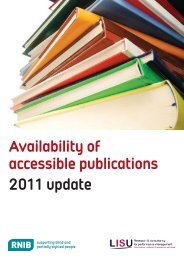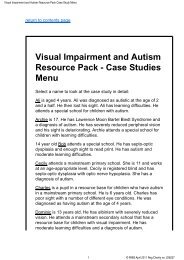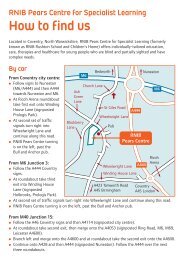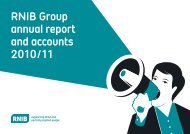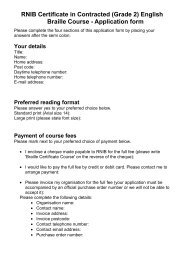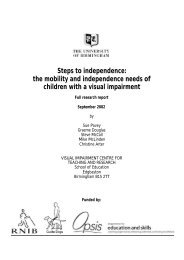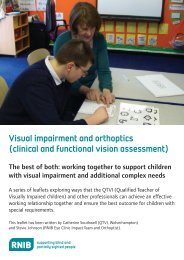Vocational rehabilitation: The business case for retaining ... - RNIB
Vocational rehabilitation: The business case for retaining ... - RNIB
Vocational rehabilitation: The business case for retaining ... - RNIB
You also want an ePaper? Increase the reach of your titles
YUMPU automatically turns print PDFs into web optimized ePapers that Google loves.
Case studies<br />
College of Occupational<br />
<strong>The</strong>rapists<br />
Further indication of the relatively<br />
low cost of interventions to achieve<br />
employment retention has been<br />
obtained through two <strong>case</strong> studies<br />
from the College of Occupational<br />
<strong>The</strong>rapists. In the first, an office<br />
worker (on a salary of £25,000)<br />
with rheumatoid arthritis, suffering<br />
from pains and limited movement<br />
in the finger and hand joints, was<br />
able to remain in work following a<br />
mere £101.94 spent on professional<br />
occupational therapist time and<br />
treatment. In the second <strong>case</strong>, a<br />
person making cardboard boxes<br />
on a salary of £15,000 incurred<br />
osteoarthritis in her carpometacarpal<br />
joint of her thumb on her left hand<br />
and carpal tunnel syndrome in her<br />
right hand. She was able to resume<br />
her duties following £145.87 being<br />
spent on professional therapist time<br />
and splints. In both instances the<br />
employee was supported to remove<br />
their need <strong>for</strong> going off sick and<br />
requiring sickness pay.<br />
On occasion more intensive<br />
interventions are required and <strong>case</strong><br />
studies bear out the value <strong>for</strong> money<br />
or <strong>business</strong> <strong>case</strong> from investing in<br />
vocational <strong>rehabilitation</strong>.<br />
“Rolls Royce saved<br />
£11 million by reducing<br />
sickness absence”<br />
Port of London Authority<br />
One example of a UK <strong>business</strong><br />
benefiting from the introduction<br />
of a sickness absence management<br />
programme is that of the Port of<br />
London Authority (PLA). <strong>The</strong> PLA<br />
improved their occupational health<br />
services and trained their line<br />
managers on the causes of absence<br />
and return to work plans. <strong>The</strong><br />
<strong>business</strong> benefits included a 70 per<br />
cent drop in staff sickness absence<br />
with a comparable reduction in longterm<br />
absence too. <strong>The</strong> gain was the<br />
equivalent of having an extra 30<br />
people at work at any one time.<br />
Rolls Royce<br />
Rolls Royce implemented a sickness<br />
absence management system and<br />
early intervention of <strong>rehabilitation</strong>.<br />
Anyone off work <strong>for</strong> more than four<br />
weeks was provided with a return-towork<br />
action plan by their line manager<br />
and occupational health support.<br />
This support included early access to<br />
in house physiotherapy. Rolls Royce<br />
invested in an IT monitoring system,<br />
staff and line managers training and<br />
some staff time in consulting on the<br />
<strong>for</strong>mation of the policy. At the time of<br />
monitoring the benefits of the policy<br />
Rolls Royce were able to identify a<br />
reduction of 28,500 work days in<br />
sickness absence from a baseline of<br />
191,000. This reduction represented<br />
a saving or some £11 million.<br />
9






